Yunsu Kim
DeRAGEC: Denoising Named Entity Candidates with Synthetic Rationale for ASR Error Correction
Jun 09, 2025
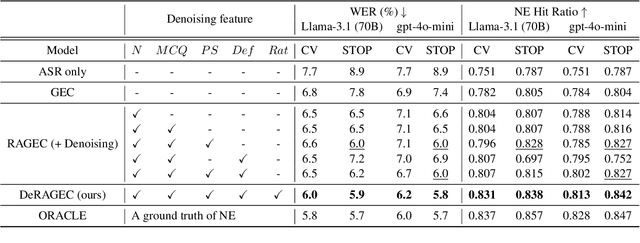

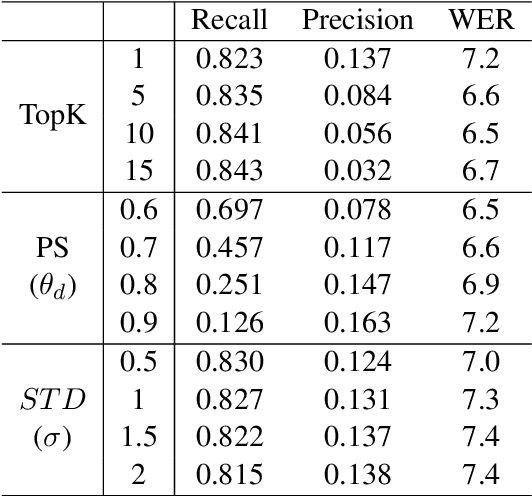
Abstract:We present DeRAGEC, a method for improving Named Entity (NE) correction in Automatic Speech Recognition (ASR) systems. By extending the Retrieval-Augmented Generative Error Correction (RAGEC) framework, DeRAGEC employs synthetic denoising rationales to filter out noisy NE candidates before correction. By leveraging phonetic similarity and augmented definitions, it refines noisy retrieved NEs using in-context learning, requiring no additional training. Experimental results on CommonVoice and STOP datasets show significant improvements in Word Error Rate (WER) and NE hit ratio, outperforming baseline ASR and RAGEC methods. Specifically, we achieved a 28% relative reduction in WER compared to ASR without postprocessing. Our source code is publicly available at: https://github.com/solee0022/deragec
MiLQ: Benchmarking IR Models for Bilingual Web Search with Mixed Language Queries
May 22, 2025



Abstract:Despite bilingual speakers frequently using mixed-language queries in web searches, Information Retrieval (IR) research on them remains scarce. To address this, we introduce MiLQ,Mixed-Language Query test set, the first public benchmark of mixed-language queries, confirmed as realistic and highly preferred. Experiments show that multilingual IR models perform moderately on MiLQ and inconsistently across native, English, and mixed-language queries, also suggesting code-switched training data's potential for robust IR models handling such queries. Meanwhile, intentional English mixing in queries proves an effective strategy for bilinguals searching English documents, which our analysis attributes to enhanced token matching compared to native queries.
Revisiting Early Detection of Sexual Predators via Turn-level Optimization
Mar 09, 2025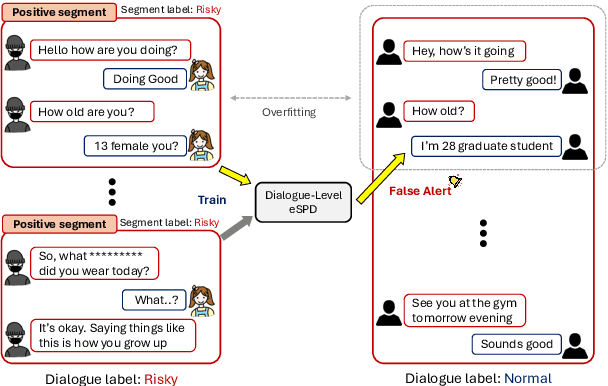



Abstract:Online grooming is a severe social threat where sexual predators gradually entrap child victims with subtle and gradual manipulation. Therefore, timely intervention for online grooming is critical for proactive protection. However, previous methods fail to determine the optimal intervention points (i.e., jump to conclusions) as they rely on chat-level risk labels by causing weak supervision of risky utterances. For timely detection, we propose speed control reinforcement learning (SCoRL) (The code and supplementary materials are available at https://github.com/jinmyeongAN/SCoRL), incorporating a practical strategy derived from luring communication theory (LCT). To capture the predator's turn-level entrapment, we use a turn-level risk label based on the LCT. Then, we design a novel speed control reward function that balances the trade-off between speed and accuracy based on turn-level risk label; thus, SCoRL can identify the optimal intervention moment. In addition, we introduce a turn-level metric for precise evaluation, identifying limitations in previously used chat-level metrics. Experimental results show that SCoRL effectively preempted online grooming, offering a more proactive and timely solution. Further analysis reveals that our method enhances performance while intuitively identifying optimal early intervention points.
DyPCL: Dynamic Phoneme-level Contrastive Learning for Dysarthric Speech Recognition
Jan 31, 2025Abstract:Dysarthric speech recognition often suffers from performance degradation due to the intrinsic diversity of dysarthric severity and extrinsic disparity from normal speech. To bridge these gaps, we propose a Dynamic Phoneme-level Contrastive Learning (DyPCL) method, which leads to obtaining invariant representations across diverse speakers. We decompose the speech utterance into phoneme segments for phoneme-level contrastive learning, leveraging dynamic connectionist temporal classification alignment. Unlike prior studies focusing on utterance-level embeddings, our granular learning allows discrimination of subtle parts of speech. In addition, we introduce dynamic curriculum learning, which progressively transitions from easy negative samples to difficult-to-distinguishable negative samples based on phonetic similarity of phoneme. Our approach to training by difficulty levels alleviates the inherent variability of speakers, better identifying challenging speeches. Evaluated on the UASpeech dataset, DyPCL outperforms baseline models, achieving an average 22.10\% relative reduction in word error rate (WER) across the overall dysarthria group.
Bel Esprit: Multi-Agent Framework for Building AI Model Pipelines
Dec 19, 2024Abstract:As the demand for artificial intelligence (AI) grows to address complex real-world tasks, single models are often insufficient, requiring the integration of multiple models into pipelines. This paper introduces Bel Esprit, a conversational agent designed to construct AI model pipelines based on user-defined requirements. Bel Esprit employs a multi-agent framework where subagents collaborate to clarify requirements, build, validate, and populate pipelines with appropriate models. We demonstrate the effectiveness of this framework in generating pipelines from ambiguous user queries, using both human-curated and synthetic data. A detailed error analysis highlights ongoing challenges in pipeline construction. Bel Esprit is available for a free trial at https://belesprit.aixplain.com.
Guide-to-Explain for Controllable Summarization
Nov 19, 2024



Abstract:Recently, large language models (LLMs) have demonstrated remarkable performance in abstractive summarization tasks. However, controllable summarization with LLMs remains underexplored, limiting their ability to generate summaries that align with specific user preferences. In this paper, we first investigate the capability of LLMs to control diverse attributes, revealing that they encounter greater challenges with numerical attributes, such as length and extractiveness, compared to linguistic attributes. To address this challenge, we propose a guide-to-explain framework (GTE) for controllable summarization. Our GTE framework enables the model to identify misaligned attributes in the initial draft and guides it in explaining errors in the previous output. Based on this reflection, the model generates a well-adjusted summary. As a result, by allowing the model to reflect on its misalignment, we generate summaries that satisfy the desired attributes in surprisingly fewer iterations than other iterative methods solely using LLMs.
Cross-lingual Transfer for Automatic Question Generation by Learning Interrogative Structures in Target Languages
Oct 04, 2024



Abstract:Automatic question generation (QG) serves a wide range of purposes, such as augmenting question-answering (QA) corpora, enhancing chatbot systems, and developing educational materials. Despite its importance, most existing datasets predominantly focus on English, resulting in a considerable gap in data availability for other languages. Cross-lingual transfer for QG (XLT-QG) addresses this limitation by allowing models trained on high-resource language datasets to generate questions in low-resource languages. In this paper, we propose a simple and efficient XLT-QG method that operates without the need for monolingual, parallel, or labeled data in the target language, utilizing a small language model. Our model, trained solely on English QA datasets, learns interrogative structures from a limited set of question exemplars, which are then applied to generate questions in the target language. Experimental results show that our method outperforms several XLT-QG baselines and achieves performance comparable to GPT-3.5-turbo across different languages. Additionally, the synthetic data generated by our model proves beneficial for training multilingual QA models. With significantly fewer parameters than large language models and without requiring additional training for target languages, our approach offers an effective solution for QG and QA tasks across various languages.
Cross-lingual Back-Parsing: Utterance Synthesis from Meaning Representation for Zero-Resource Semantic Parsing
Oct 01, 2024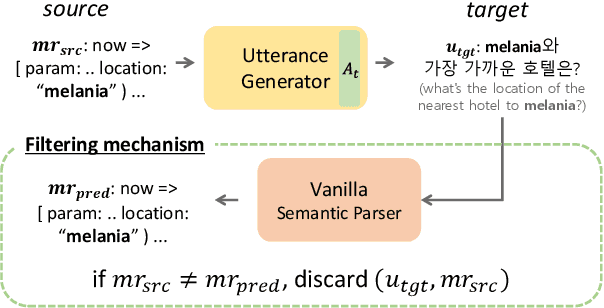
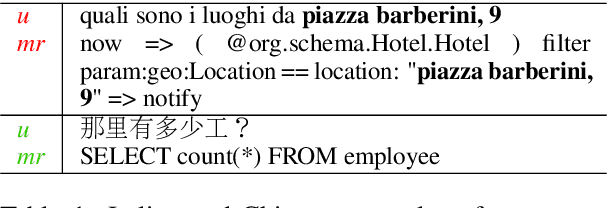
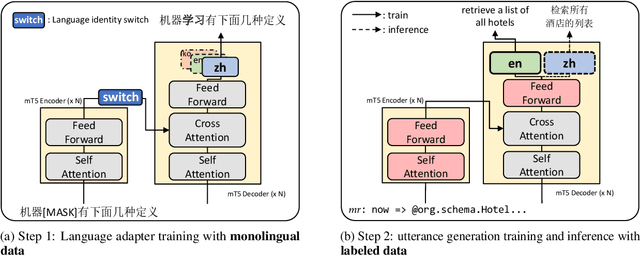
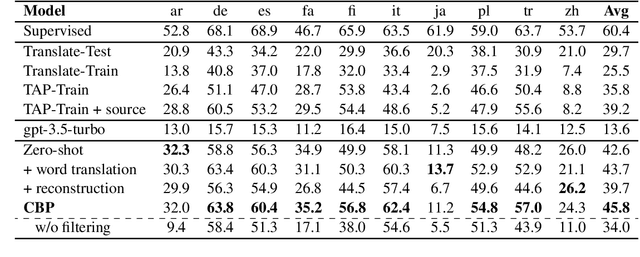
Abstract:Recent efforts have aimed to utilize multilingual pretrained language models (mPLMs) to extend semantic parsing (SP) across multiple languages without requiring extensive annotations. However, achieving zero-shot cross-lingual transfer for SP remains challenging, leading to a performance gap between source and target languages. In this study, we propose Cross-Lingual Back-Parsing (CBP), a novel data augmentation methodology designed to enhance cross-lingual transfer for SP. Leveraging the representation geometry of the mPLMs, CBP synthesizes target language utterances from source meaning representations. Our methodology effectively performs cross-lingual data augmentation in challenging zero-resource settings, by utilizing only labeled data in the source language and monolingual corpora. Extensive experiments on two cross-language SP benchmarks (Mschema2QA and Xspider) demonstrate that CBP brings substantial gains in the target language. Further analysis of the synthesized utterances shows that our method successfully generates target language utterances with high slot value alignment rates while preserving semantic integrity. Our codes and data are publicly available at https://github.com/deokhk/CBP.
An Investigation Into Explainable Audio Hate Speech Detection
Aug 12, 2024Abstract:Research on hate speech has predominantly revolved around detection and interpretation from textual inputs, leaving verbal content largely unexplored. While there has been limited exploration into hate speech detection within verbal acoustic speech inputs, the aspect of interpretability has been overlooked. Therefore, we introduce a new task of explainable audio hate speech detection. Specifically, we aim to identify the precise time intervals, referred to as audio frame-level rationales, which serve as evidence for hate speech classification. Towards this end, we propose two different approaches: cascading and End-to-End (E2E). The cascading approach initially converts audio to transcripts, identifies hate speech within these transcripts, and subsequently locates the corresponding audio time frames. Conversely, the E2E approach processes audio utterances directly, which allows it to pinpoint hate speech within specific time frames. Additionally, due to the lack of explainable audio hate speech datasets that include audio frame-level rationales, we curated a synthetic audio dataset to train our models. We further validated these models on actual human speech utterances and found that the E2E approach outperforms the cascading method in terms of the audio frame Intersection over Union (IoU) metric. Furthermore, we observed that including frame-level rationales significantly enhances hate speech detection accuracy for the E2E approach. \textbf{Disclaimer} The reader may encounter content of an offensive or hateful nature. However, given the nature of the work, this cannot be avoided.
KpopMT: Translation Dataset with Terminology for Kpop Fandom
Jul 10, 2024



Abstract:While machines learn from existing corpora, humans have the unique capability to establish and accept new language systems. This makes human form unique language systems within social groups. Aligning with this, we focus on a gap remaining in addressing translation challenges within social groups, where in-group members utilize unique terminologies. We propose KpopMT dataset, which aims to fill this gap by enabling precise terminology translation, choosing Kpop fandom as an initiative for social groups given its global popularity. Expert translators provide 1k English translations for Korean posts and comments, each annotated with specific terminology within social groups' language systems. We evaluate existing translation systems including GPT models on KpopMT to identify their failure cases. Results show overall low scores, underscoring the challenges of reflecting group-specific terminologies and styles in translation. We make KpopMT publicly available.
 Add to Chrome
Add to Chrome Add to Firefox
Add to Firefox Add to Edge
Add to Edge